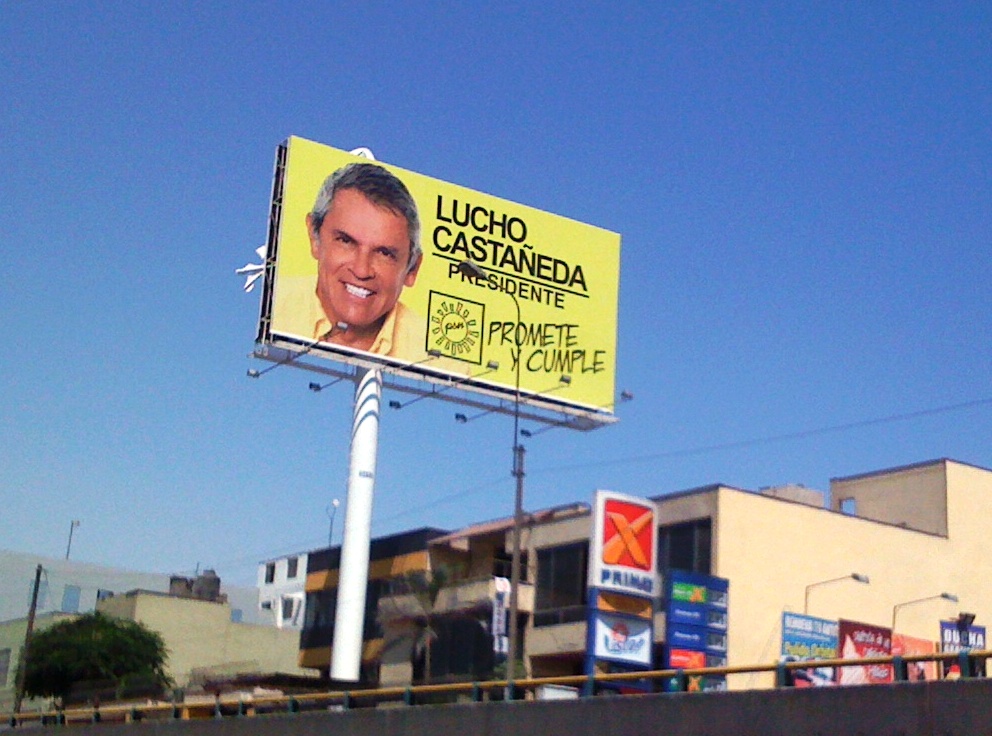
By Geeta Uhl, KF 14, Peru
Elections take place on April 10 in Peru. Voting is mandatory and enforced for everyone aged 18-75 years (in the last election voter turnout in Peru was 88%, compared to 57% in the U.S. in 2008), and there is even a 3-day national dry period before elections and on Election Day. The presidential seat is up for grabs (President Alan Garcia cannot run again due to a ban on consecutive terms) as are 130 congressional seats and 5 Parliament seats. For the last month there have been large billboards and banners all over Lima and Ayacucho, where I am currently living, highlighting a variety of election claims and promises, from eradicating corruption in Congress, re-installing the death penalty, reforming education, to promoting physical fitness.
There are 5 main candidates vying for the Presidency. The two right wing parties are Solidaridad Nacional (National Solidarity) led by Luis Castaneda, 65, the former mayor of Lima, and Fuerza 2011 (Force 2011) led by jailed ex-President Fujimori’s daughter and current congresswoman Keiko Fujimori, 35. Her father is currently serving 25 years for human rights abuses and if elected she has vowed to grant him a presidential pardon.
Peru Posible (Possible Peru) is led by former president Alejandro Toledo, 64, an academic who received his doctorate from Stanford University and was President of Peru from 2001-2006. The left wing party is Gana Peru (Win Peru), led by Ollanta Humala, 48, a former army officer who narrowly lost the 2006 Presidential election. Pedro Kuczynski entered the race in December last year, and is part of the Alliance for Change Party, considered center-right. He is the most unusual and atypical of all of the candidates, a former World Bank official and Wall Street banker with dual Peruvian-American citizenship. There is nobody running from current President Garcia’s party, who currently has an approval rating of 26%.

More billboards in Lima. On the right, Congressman Lucho Galarreta, who was born without hands, incorporates this into his campaign, saying that "nobody will break my hand" in the fight against corruption
A 5-way tie?
In 2010, Fujimori and Castaneda were leading the polls; earlier in March, Toledo was in the lead with Fujimori and Castaneda following close behind and Humala and Kuczynski were trailing; and as of Monday, a major poll had Humala in the lead with 21.2 percent, with early frontrunner Alejandro Toledo trailing with 20 percent, Keiko Fujimori with 19 percent, and Pedro Kuzynski and Luis Castañeda logging 15 and 14 percent, respectively. Upon hearing this news the Peruvian sol dropped to its lowest value in 21 months. Humala seeks to increase state control over the economy, including Peru’s ports and natural gas reserves and was strongly linked to President Chavez in the 2006 elections. As a result, his rise in polls caused investors to sell Peruvian bonds.

Kenji Fujimori, Keiko's younger brother (with his father, the jailed former President, pictured behind him), is also running for office. His campaign slogan says he works as hard as "el chino", most likely referring the former nickname of his father
Dirty Politics
Mario Vargas Llosa, the recent Peruvian Nobel Prize winner (and Presidential candidate against Fujimori in 1990) has likened the race to a “variety show” and a “tournament of clownish like behaviors” in a recent Wall Street Journal article. Scanning the front page of Peru’s most popular newspapers during the month of March, it has not been uncommon to see allegations of candidates using cash from druglords to finance their campaigns; accusations that one candidate was too old to run and had Alzheimer’s (Kuczynski, at 72 years old); accusations that Toledo is a heavy drinker and uses cocaine; and even claims from the current President Garcia that Toledo has a “psychosexual obsession” with him. Lately, other candidates have accused Humala, who is leading the polls, of being a communist in disguise, a potential dictator, and a soldier of Venezuela’s President Chavez.

Typical news headlines of candidates making accusations. In this one, Keiko Fujimori accuses Humala of not changing since the last campaign in 2006 when he was portrayed as a radical leftist
Main areas of contention?
Unfortunately most of what is reported here in the news reflects the random allegations between contenders so it is a bit difficult to ascertain where the candidates actually stand on the main issues of concern (and to even know what issues Peruvians care about). Regarding the economy, Humala has stated that he wants to nationalize industries and re-negotiate Peru’s trade agreements. Toledo and Humala also want to increase mining taxes (Peru is the second-leading copper producer, the largest silver producer and the fifth-largest gold producer), whereas the others don’t want to change tax laws.
On civil unions, Toledo “supports civil unions but does not promote gay marriage”. Fujimori supports civil unions whereas Humala is against them. Kuczynski has expressed a ambitious desire to eliminate extreme poverty in ten years, increase education spending while also cutting taxes.
Given that 50 percent of the votes are needed on April 10 to avoid a run-off (scheduled for June 5 if necessary), the race for the presidency is still wide open. And considering Peru’s history of elections (in 1990 the original Fujimori had only 5% of the vote 2 weeks before election day and ended up winning in the run-off), at this point, any of the top five candidates could enter into a second round run-off and win.
Geeta Uhl is currently serving as a Kiva fellow at FINCA Peru in Ayacucho, Peru.
PREVIOUS ARTICLE
Passport Series: Pakistan: Part Three: Microfinance and Natural Disasters →NEXT ARTICLE
Microfinance Notes: 30 March 2011 →
















